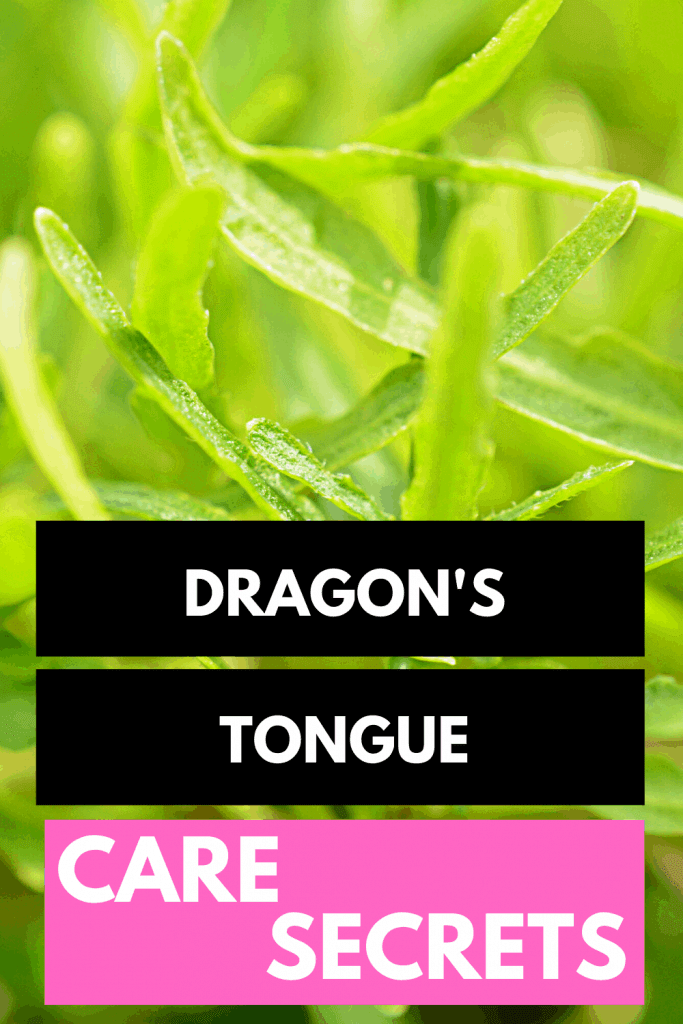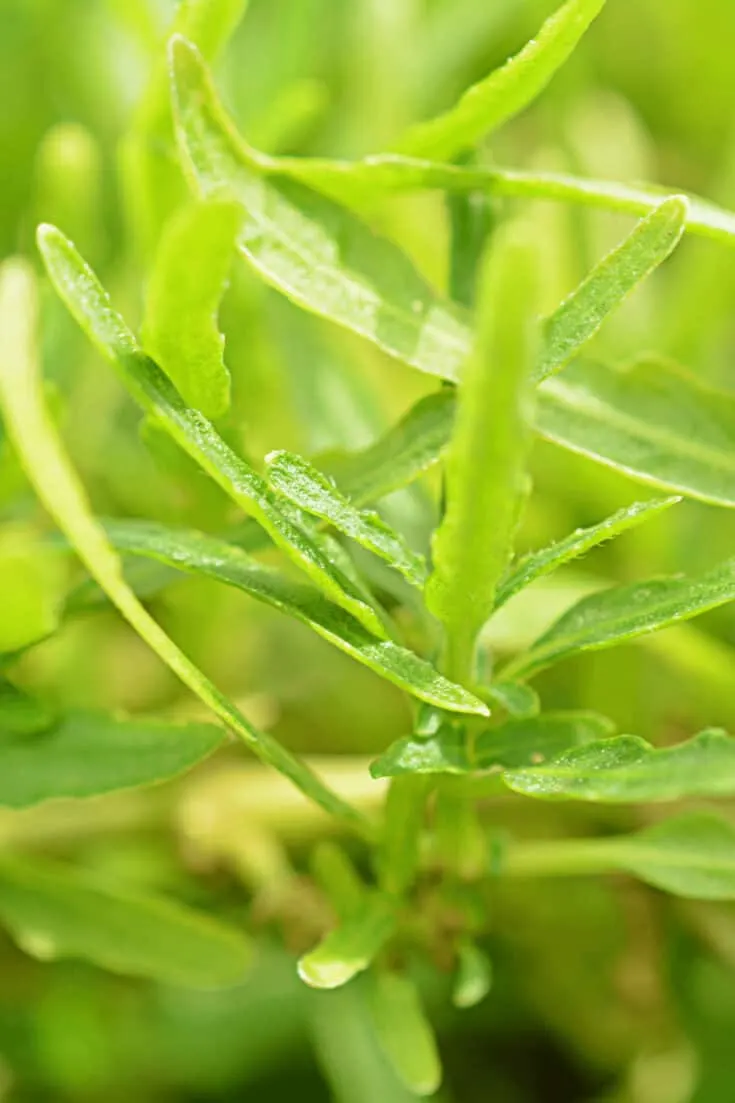Hemigraphis repanda, which is commonly known as the Dragon’s Tongue.
Dragon’s Tongue Care
Provide your Dragon’s Tongue with bright, indirect light. Water it when the top layers of the soil are dry to the touch. Use well-draining soil. Average to warm temperatures between 60°F to 75°F (16°C -24°C) and high humidity >50%. Fertilize monthly in spring and summer with a liquid fertilizer at 1/2 strength.

Dragon’s Tongue Care
Table of Contents
Dragon’s Tongue Care Guide
SOIL
Well-draining soil is what the Dragon’s Tongue likes best.
Any regular houseplant potting mix that matches this criterion should just do fine.
LIGHT
Bright, indirect sunlight is the best for your Dragon’s Tongue.
Especially when direct sunlight is in the mornings. This is the case with and east-facing window.
Read our article about the different window directions and their impact on the best light levels for your plants.
WATERING
Water your Waffle plant (yet another fancy name for the Hemigraphis repanda!) whenever the soil is turning from being slightly moist to dry.
It is, however, impossible to tell you exactly how many times your plant needs to be given water.
The reason for this is simply that the watering routine depends on too many factors, such as your location and where you actually keep your plant, the choice of soil, the temperature & many more.
Therefore, the best way to check if your Hemigraphis repanda is indeed in need of a drink, is to use your index finger.
Stick your index finger into the soil up to the knuckle and check if it is dry to the touch. If it is indeed dry, give your plant a drink.
If it is still somewhat moist, don’t water your plant just yet.
TEMPERATURE
The best temperature range for your Dragon’s Tongue is 60°F to 75°F (16°-24°C).
Therefore, your Waffle plant feels comfortable in average room temperatures.
In winter, (when grown outdoors!), make sure that temperatures don’t drop below 40°F (4°C).
Don’t place your Hemigraphis repanda near a heater or radiator.
HUMIDITY
As a tropical plant, the Dragon’s Tongue prefers high humidity >50%.
While this plant can survive at lower humidity levels, it will only unfold its true potential at higher humidity levels.
Here are a few humidity hacks for all you plant parents out there:
- Group tropical plants together. This will help quite a bit with increasing humidity levels.
- Make use of a pebble try filled with water underneath your Hemigraphis repanda
- Spray the leaves of your Hemigraphis repanda daily (this only helps a little bit and only temporarily but is still better than nothing)
- Make use of a humidifier
- Make the bathroom the home of your Hemigraphis repanda. This only works if enough sunlight (bright, indirect light) is still guaranteed.
Any or all of these methods in combination can increase drastically increase the humidity and will ultimately lead to a better and bigger growth of your plant.

Hemigraphis repanda prefers high humidity above 50%
FERTILIZER
Fertilize your Dragon’s Tongue once a month with a diluted liquid fertilizer to 1/2 strenght in summer and spring and reduce fertilizing in autumn and winter.
Also, make sure to have a look at our in-depth houseplant fertilization guide.
Nutrients in fertilizers are listed by an NPK ratio. NPK stands for the macronutrients: nitrogen (N), phosphorus (P), and potassium (K).
In fall and winter, fertilizing your Hemigraphis repanda won’t be necessary, as it is dormant.
As far as the choice of fertilizer goes, any high-quality houseplant fertilizer should do.
I usually go with a balanced liquid fertilizer (diluted at half strength).
PROPAGATION
The easiest way to propagate Hemigraphis repanda is by taking stem cuttings.
To propagate your Hemigraphis repanda, do the following
- Use sterile scissors and take several stem cuttings. The cuttings should be about 3 to 4 inches long.
- Prepare a new pot (about 6 inches) and fill it with the potting medium of your choice (well-draining potting mix is recommended).
- Remove the lower leaves of your cuttings
- Stick the cuttings into the soil (if you use a six-inch pot, you can easily put 3-5 cuttings into the very same pot).
- Keep your new plant in a shady, warm location for about 1-2 weeks.
- Water your cuttings from time to time. You can use a hand mister for that purpose.
GROWTH
Dragon’s Tongue is a low-spreading plant that grows 12-15” tall and 13” wide.
Outside, it makes for a nice groundcover.
Also, this plant makes a great terrarium plant.
As far as the growth of the Waffe plant goes, it typically just grows about 12 to 15 inches tall and 13 inches wide.
POTTING
How do you pot a Hemigraphis repanda?
The pot itself is actually not that important.
On the other hand, what is important, is that your pot has drainage holes, as it is essential that excess water can drain out quickly.
A little suggestion: Put some sort of stone or net onto the drainage hole, so that you can avoid flushing out all of your potting mix.
Also, make sure that your pot is not too big. A pot too big for your plant often leads to root rot. You don’t want that. Believe me.
Hemigraphis repanda Problems
Yellow leaves, root rot, droopy leaves, curling leaves, and so on and so forth. There are so many things that can go wrong with your houseplants.
That said, what are the most common problems you might face as a plant parent of the Hemigraphis repanda?
Problem #1: Green Leaves
The Hemigraphis repanda’s foliage is supposed to be purple (to a good extent).
If you can hardly see any purple, chances are that your Hemigraphis repanda plant does not get enough sunlight.
To solve the problem, move your plant to a brighter location.
Problem #2: My Hemigraphis repanda’s Tongue doesn’t bloom
First of all, it needs to be said that when grown indoors, many houseplants hardly ever bloom.
The reason for this is simply that the growing conditions at home often don’t match the growing conditions of a certain plant in nature.
Now, as for your Hemigraphis repanda, it could potentially bloom even when grown as a houseplant.
If it doesn’t, it might be that the humidity is too low (humidity hacks: mist it regularly, group it together with other tropical plants, put on a trey with damp pebbles).
Also, make sure that your Hemigraphis repanda gets enough bright, indirect sunlight.
Plant Pests
It is always a good idea to monitor your houseplants for plant pests.
While some houseplants are particularly susceptible to plant pest infestations, some others are less likely to be attacked by plant pests such as aphids, springtails & spider mites.
Now, as far as the Hemigraphis repanda is concerned, while not terribly prone to pest infestations, at some point you might have to deal with mealybugs, scale insects, or whiteflies.
Frequently Asked Questions About Hemigraphis repanda
What other names does the Dragon’s Tongue plant have?
The botanical name of the Dragon’s Tongue plant is “Hemigraphis repanda.” Another nickname that the Dragon’s Tongue goes by is “Dragon’s Breath.”
&How long do Dragon’s Tongues live?
The longevity of a Dragon’s Tongue mainly depends on the climate and specifically on the temperature. To make sure that your plant can survive for many years to come, you would to need to make sure temperatures do not drop below 41 Fahrenheit (5 degrees) in winter.
Is the Dragon’s Tongue an aquarium plant?
No. In fact, when the Dragon’s Tongue plant is completely submerged, it is very likely to die.
Is Hemigraphis repanda toxic to cats?
Yes. Keep this plant away from your cats.
Is Hemigraphis repanda toxic to dogs?
Yes. Keep this plant away from your dogs.
Can the Dragon’s Tongue plant survive in low light?
Yes. However, low light is not ideal. It will result in stunted growth and will have a negative effects on the foliage of the plant.
Do I need to prune my Dragon’s Tongue?
Hemigraphis repanda is a low-spreading plant. Pruning is usually not necessary. However, if needed, you can prune it back at any time.

Daniel has been a plant enthusiast for over 20 years. He owns hundreds of houseplants and prepares for the chili growing seasons yearly with great anticipation. His favorite plants are plant species in the Araceae family, such as Monstera, Philodendron, and Anthurium. He also loves gardening and is growing hot peppers, tomatoes, and many more vegetables.


